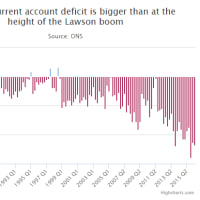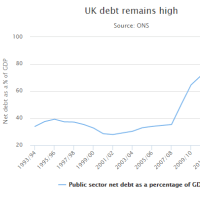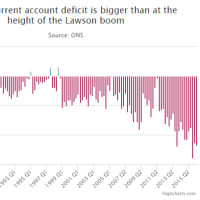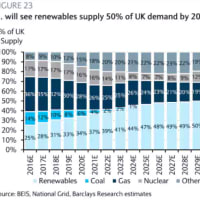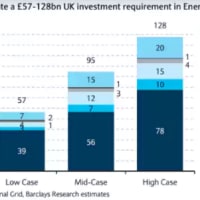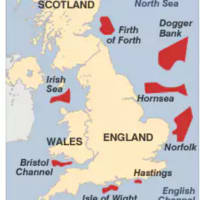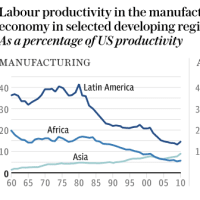Funds try to spot the great oil rebound
(ファンド、石油価格の大リバウンドを狙う)
BY Ambrose Evans-Pritchard
Telegraph:19 Apr 2009
(ファンド、石油価格の大リバウンドを狙う)
BY Ambrose Evans-Pritchard
Telegraph:19 Apr 2009
Oil is too cheap. At around $50 a barrel, it is trading far below the production costs of almost all new sources of crude and energy substitutes.
石油が安過ぎる。1バレル約50ドルなんて、ほぼ全ての新油田や代替エネルギーの原価を遥かに下回る値段で取り引きされているのだ。
A sustained price above $70 is needed to cover investments in Canada's tar sands, the deep-water fields off Brazil, and Russia's "High North" above the Arctic Circle.
カナダのタールサンド、ブラジルの深海底油田、そしてロシアの北極圏辺りの「ハイノース」への投資をカバーするために必要な石油の値段は70ドル以上だ。
Much the same goes for biofuels from grains (sugar is cheaper). They matter. Bioethanol swings the global crude price. It accounted for 60pc of extra oil supply worldwide from 2007-2008.
穀物から作るバイオ燃料(砂糖の方が安いけどね)についても、事態はほぼ同じである。
これは問題だ。
バイオエタノールは国際原油価格を左右する。
石油供給量に換算すると、2007-2008年は世界全体で60%追加供給したことになる。
Crude at $50 does not square with the failure of the big oil companies to replace reserves over the last five years, or with the lack of coal and nuclear plants to plug the gap. It takes 10 years or so to put a nuclear power station into service.
原油価格が50ドルでは、大手石油企業がこの5年間新しい油田を開発してこなかったこと、もしくは、ギャップを埋めるための石炭や原発がないことを埋め合わせられないのだ。
原発を稼動させるには10年ほどかかるのに。
Nor is it compatible with the breakneck industrialisation of Asia. China expects to have 140m cars on its roads by 2020, up sevenfold in a decade.
アジアの猛スピード産業化にも合っていない。
中国は2020年までには1億4,000万台、10年で7倍の数の車が運転されるようになるだろう、と予測している。
So unless the world economy tips into acute deflation (possible: prices are already falling in the US, China, Japan, Spain, and Switzerland) and unless the G20's monetary stimulus fails to prevent a slide into protracted depression, it is a safe bet that oil prices will roar back.
だから、世界経済が危機的デフレに落ち込まない限り(可能性はある:米国、中国、日本、スペイン、スイスでは既に物価が下がっている)、そしてG20金融刺激策が長期的布教への突入阻止に失敗しない限り、石油価格は再び猛烈に値上がりすることだろう。
Investors are already itching to buy tickets for the great rebound. ETF Securities reports a "meteoric rise" in flows into its family of oil funds, which trade like equities on global bourses. Their funds alone have jumped sixfold to $1.3bn (£880m) since October. Buying reached a crescendo early this year as OPEC production cuts began to stabilise crude after prices touched $34 – a long way down from the giddy heights of $147 last July.
投資家は既にグレート・リバウンドに賭けたくてウズウズしている。
ETFセキュリティーは、世界の株式市場で株のように取り引きする石油系ファンドへの資金流入が「急激に増加している」と伝えている。
同社のファンドだけでも昨年10月以来、6倍の13億ドルに膨れ上がった。
買い付けは、昨年7月の147ドルなんて眩暈がしそうな値段から遥か下、34ドルをつけた後、OPECの減産で原油価格が安定し始めた今年先にピークを迎えた。
But investors are discovering that it is harder to play the energy rally than it looks. The crude oil fund (CRUD) has fallen by 27pc since early January, though oil itself has risen 9pc since then. The leveraged oil fund (LOIL) has halved. This is the painful story of countless commodity funds. You make the right strategic call, but come to grief on the details.
しかし投資家は、エネルギー・ラリーで儲けるのは思ったよりも難しい、と見出しつつある。
1月上旬以来、石油そのものの値段は9%上昇したが、原油ファンド(CRUD)は27%値下がりした。
レバレッジド・オイル・ファンド(LOIL)は半分になってしまった。
これが星の数ほどもある商品ファンドのイタイところだ。
あなたは正しい戦略的なコールをするかもしれないが、些細なところで災難に遭う。
The reason is "contango". Futures prices have been trading far above spot prices – precisely because the markets are already betting on a V-shaped oil recovery. This forces the ETF funds to keep rolling over futures contracts at a loss – known as "negative roll yield".
その原因は「コンタンゴ」だ。
先物価格はスポット価格よりも遥かに高い。
これは正に市場が石油価格のV字回復に賭けているからだ。
このフォースがETFファンドに損を出しながらの先物契約ロールオーバーを強い続ける…いわゆる「ネガティブ・ロール・イールド」だ。
Contango has moderated, but December contracts are still near $60. Oil has to rise briskly for the funds to break even. Handle with care.
コンタンゴは収まったが、12月契約はまだ60ドル近い。
とんとんにするためには、石油はさっさと値上がりしなければいけないのだ。
取り扱い注意ですな。
Michael Lewis, commodities chief at Deutsche Bank, said it is too early for investors to jump back into oil in any case. "We think these reflation trades are in danger of unravelling. Oil may fall back to $40 later this year before it finds a floor."
ドイチェ・バンクのコモディティ・チーフ、マイケル・ルイス曰く、なんでもいいけど投資家焦り過ぎ、とのこと。
「こんなリフレーション・トレードは崩壊の危機にあると思うよ。石油なんて底打ちする前に、また今年中に40ドルになるかもしれないじゃん」。
It usually takes a year or more for OPEC to flush excess supply out of the market. The cartel has moved fast this time – agreeing to cuts of 4.2m barrels per day (b/d), 80pc delivered so far – but is struggling to keep pace with the staggering collapse of demand. Japan's industrial output has fallen 38pc.
通常、OPECが過剰供給した分を市場からなくすには、1年以上かかる。
同カルテルは今回は素早かった(これまでの2割減、一日420万バレルの減産に合意)が、落ち込む需要と歩調を合わせるのに悪戦苦闘している。
日本の工業生産は38%落ち込んだ。
Deutsche Bank says China's spring rally is a false dawn. The 26pc fall in Chinese exports in February (-17pc in March) will curb plant investment six to nine months later, just as the $600bn fiscal stimulus runs out of juice.
ドイチェ・バンクによれば、中国の春のラリーは騙しだそうな。
中国の2月の輸出は26%落ち込んだ(3月は-17%)が、これは6-9ヵ月後に設備投資を減少させるわけだ。
そう、6,000億ドルの財政刺激策が枯渇する丁度その頃である。
The markets have almost certainly jumped the gun by betting on an end to the US recession by July, ignoring the gloomier – and reliable – message of US leading indicators. Deutsche expects one more shake-out on global markets this summer before the coast is clear, with economic recovery starting in earnest at the end of the year.
7月までに米国不況が終わるだろう、なんてほぼ確実に市場の早とちりだ。
米国リース指標のもっと陰鬱(だけど信頼出来る)メッセージを無視している。
ドイチェ・バンクは、今夏、全てクリアとなる前に、世界市場でもう1回以上振り落としがあり、回復が本当に始まるのは年末だ、と予測している。
One thing is certain, the next cycle will not repeat the early 1980s when crude languished for years as the market digested a surfeit of supply from new fields of the North Sea, the Gulf of Mexico, and Alaska – all now in frightening depletion.
一つ確実なことは、
次のサイクルが、市場が北海油田、メキシコ湾、そしてアラスカの新油田からの過剰供給を消化して、原油が何年間も激安だった、1980年代初頭の再現にはならないということだ。
今じゃこれ全部枯渇寸前状態だし。
This time there is no easy oil coming on stream. Tomorrow's fields are mostly deep in the ocean, beneath salt, or in political no-go zones. Lukoil's Leonid Fedun doubts whether Russia's production will ever again reach 10m b/d. Petrobras has stretched its plans to develop Brazil's Tupi field in the Atlantic. The US rig count has halved since September.
今回、簡単に採掘出来る石油はない。
未来の油田の殆どは深海底油田か、政治的に立ち入り禁止地域にある。
ルクオイルのLeonid Fedunは、ロシアの石油生産が再び1,000万バレル/日に回復する日なんてあるかしらん、と懐疑的だ。
ペトロブラスはブラジルのツピ油田開発計画を引き伸ばした。
米国のリグの台数は9月以来半分になった。
Green energy pioneers are falling likely flies – sadly – as funding dries up. Shell, BP, and Iberdrola are cutting back on wind farms. Future energy supply is being turned off everywhere, and cannot easily be switched back on.
グリーン・エネルギーのパイオニアは、資金が枯渇するにつれ(悲しいかな)ハエのごとくバタバタと落ちている。
シェル、BP、イベルドローラはウィンドファームを縮小している。
未来のエネルギー供給はそこら中で止められている上に、これを戻すことは容易ではない。
The International Energy Agency (IEA) expects an almighty crunch in three or four years as China's oil demand nears 10m b/d, up from 6.7m in 2005 (global demand is 83.4m). After that, it gets steadily worse. Four "Saudi Arabias" are needed to plug the gap by 2030.
IEAは、中国の石油需要が2005年の670万バレルから1,000万バレル/日に増加する3-4年の間に、大クランチが来るだろうと予想している(世界需要は8,340万バレル)。
その後、事態は徐々に悪化する。
2030年までにこのギャップを埋めるためには「サウジアラビア」が4つ必要だ。
Investors have countless ways to bet on Peak Oil. My favourite is solar power, as new technology brings it nearer "grid parity" with fossil fuels. The sun's radiation must ultimately be the answer, but you have to navigate with care through the wreckage of credit-squeezed solar start-ups.
投資家がピークオイルに金を賭ける方法は無数に存在する。
僕のお気に入りはソーラーパワーだ。
新技術が化石燃料との「グリッドパリティ」を近付けつつある。
太陽光こそ最後の答えに違いない。
でもまあ、金にかつかつの新興ソーラーパワー会社の残骸の間は、慎重に動かなきゃだめだよ。
Oil ETFs will have their day again, if contango is ever tamed. For those who prefer plain stocks, BP offers a dividend of 7.3pc; Total is at 7pc, and Shell at 6pc. But be mindful of their exposure to capricious regimes and the risk of galloping rig costs.
コンタンゴが落ち着くなんてことがあれば、石油ETFもまた人気になるかもね。
プレーンがお好みの皆様のためにお伝えすると、BPの配当利回りは7.3%、トタルは7%、シェルは6%であります。
でも、連中がヤバい政権にエクスポージャーしてることとか、採掘コストが一気に噴くリスクとかいうこともあるから、注意してね。
Above all, don't rush. The history of oil cycles tells us that you have a few more months to make up your mind.
兎に角、落ち着きなさいって。
石油サイクルの歴史が教えてるでしょ。
未だあと数ヶ月間、腹を決める時間はあるって。










